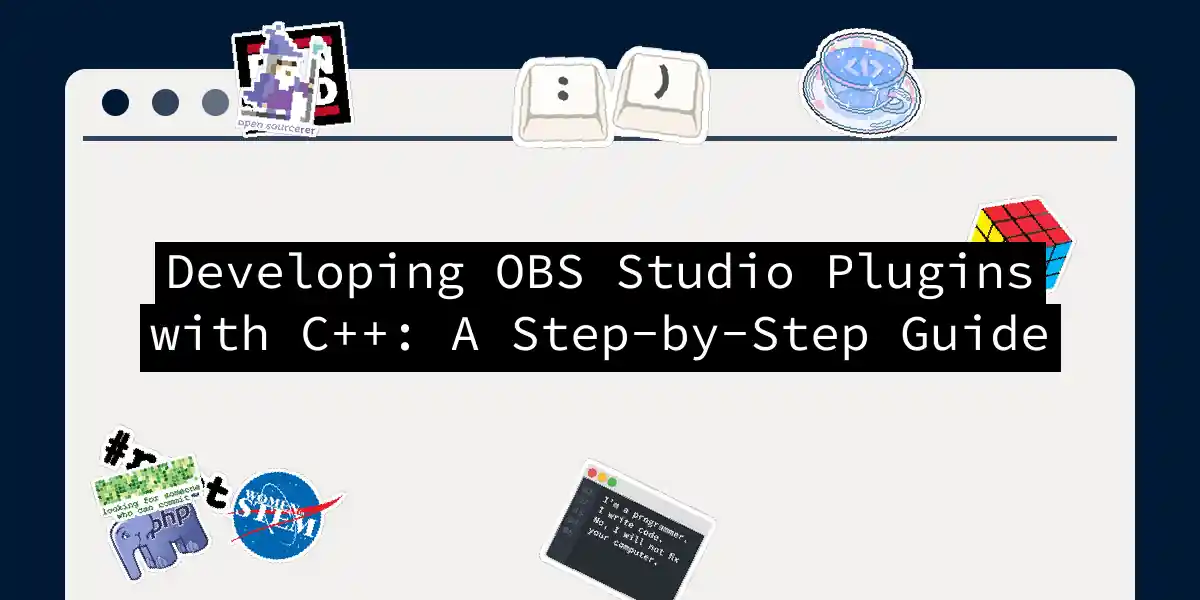Introduction to OBS Studio Plugin Development
If you’re a streamer, YouTuber, or just someone who loves tinkering with video streaming software, you’ve probably heard of OBS Studio. One of the most powerful features of OBS is its ability to be extended through plugins. In this article, we’ll dive into the world of developing OBS Studio plugins using C++, a journey that’s both challenging and rewarding.
Why C++?
C++ is the native language for developing OBS plugins, offering direct access to all the features and functionalities of OBS Studio. While scripting languages like Lua and Python are also supported, C++ provides the most comprehensive and performance-oriented way to create plugins.
Setting Up Your Development Environment
Before you start coding, you need to set up your development environment. Here are the steps to get you started:
Downloading the OBS Plugin Template
The first step is to download the OBS plugin template from the official OBS GitHub repository. This template provides a solid foundation for your plugin development[1].
git clone https://github.com/obsproject/obs-plugintemplate.git
Installing Necessary Tools
You’ll need a few tools to build and compile your plugin:
- Microsoft Visual Studio: This is recommended for Windows users. Ensure you have the C++ extension installed.
- CMake: A cross-platform build system generator.
- C++ Compiler: Ensure your compiler supports C++11.
- QT Framework: OBS uses QT for its GUI, so you’ll need to install QT 5.9.2 or a compatible version[4].
Building Dependencies
Here are the dependencies you need to ensure are present on your system:
- CMake
- C++ Compiler
- obs-studio (compatible with version 20.0.1 or later)
- QT Framework (5.9.2 or compatible)
- libconfig (1.5 or compatible)
- libOpencastIngest (if applicable for your specific plugin needs)[4].
Step-by-Step Guide to Creating a Plugin
Step 1: Configure Your Plugin
Open the build.json file in the plugin template directory. Here, you’ll need to change the plugin name and other details to match your project.
{
"name": "YourPluginName",
"description": "A brief description of your plugin",
"version": "1.0.0",
"author": "Your Name"
}
Step 2: Initial Plugin Test
Before adding any functionality, it’s a good idea to test if your plugin can be loaded by OBS. Build your plugin using the following commands:
On Linux:
mkdir build
cd build/
cmake -DCMAKE_BUILD_TYPE=Release ..
cmake --build .
On Windows (using MinGW):
mkdir build
cd build/
cmake -G "Visual Studio 15 2017" -DCMAKE_BUILD_TYPE=Release ..
cmake --build . --config Release
Copy the compiled DLL file to the OBS plugins directory and restart OBS to see if your plugin is recognized[4].
Step 3: Adding Basic GUI to Your Plugin
To add a GUI to your plugin, you’ll need to use the QT framework. Here’s an example of how you might create a simple dock widget:
#include <obs-module.h>
#include <obs-frontend-api.h>
#include <QDockWidget>
#include <QMainWindow>
#include <QVBoxLayout>
OBS_DECLARE_MODULE()
OBS_MODULE_USE_DEFAULT_LOCALE(PLUGIN_NAME, "en-US")
class CustomDockWidget : public QDockWidget {
public:
CustomDockWidget(QWidget *parent = nullptr) : QDockWidget(parent) {
obs_log(LOG_INFO, "Creating CustomDockWidget");
QWidget *content = new QWidget(this);
QVBoxLayout *layout = new QVBoxLayout(content);
// Add your GUI elements here
setWidget(content);
}
};
Step 4: Integrating with OBS API
The OBS API is extensive and well-documented. Here’s how you might interact with the OBS API to add a source, for example:
#include <obs.h>
void add_source() {
obs_source_t *source = obs_source_create("text_gdiplus", "MyTextSource", NULL, NULL);
if (source) {
obs_scene_t *scene = obs_frontend_get_current_scene();
if (scene) {
obs_sceneitem_t *item = obs_scene_add(scene, source);
if (item) {
obs_sceneitem_set_visible(item, true);
}
}
obs_source_release(source);
}
}
Example Plugin: A Simple Countdown Timer
Let’s create a simple countdown timer plugin to illustrate the process.
Step 1: Create the Plugin Structure
Create a new directory for your plugin and copy the necessary files from the OBS plugin template.
Step 2: Define the Countdown Logic
Here’s a basic example of how you might implement a countdown timer:
#include <obs-module.h>
#include <obs-frontend-api.h>
#include <QTimer>
#include <QLabel>
class CountdownTimer : public QDockWidget {
public:
CountdownTimer(QWidget *parent = nullptr) : QDockWidget(parent) {
QWidget *content = new QWidget(this);
QVBoxLayout *layout = new QVBoxLayout(content);
QLabel *label = new QLabel("Countdown: 10 seconds", content);
layout->addWidget(label);
setWidget(content);
QTimer *timer = new QTimer(this);
connect(timer, &QTimer::timeout, [label]() {
static int seconds = 10;
label->setText(QString("Countdown: %1 seconds").arg(seconds));
if (--seconds == 0) {
timer->stop();
}
});
timer->start(1000); // 1000 milliseconds = 1 second
}
};
Step 3: Register the Plugin
Register your plugin with OBS using the OBS_DECLARE_MODULE macro:
OBS_DECLARE_MODULE()
OBS_MODULE_USE_DEFAULT_LOCALE(PLUGIN_NAME, "en-US")
bool obs_module_load(void) {
// Create and register your plugin here
return true;
}
void obs_module_unload(void) {
// Clean up here
}
Diagram: Plugin Initialization Flow
Conclusion
Developing plugins for OBS Studio using C++ is a powerful way to extend the functionality of this versatile streaming software. With the right tools, a bit of patience, and some coding skills, you can create plugins that enhance your streaming experience. Whether you’re adding a simple countdown timer or a complex scene switcher, the possibilities are endless.
Remember, the OBS community is active and supportive, with extensive documentation and forums available to help you through any challenges you might face. So, dive in, get creative, and make OBS Studio even more amazing
